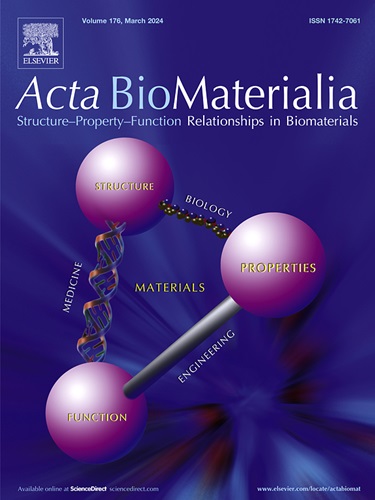Biodegradable ultrahigh-purity magnesium and its alloy ZX00 promote osteogenesis in the medullary cavity and glycogenolysis in the liver
IF 9.4
1区 医学
Q1 ENGINEERING, BIOMEDICAL
引用次数: 0
Abstract
Magnesium (Mg)-based implants have become an attractive alternative to conventional permanent implants in the orthopedic field. While biocompatibility, degradation kinetics, and osseointegration of Mg-based implants have been mostly investigated, the impact of degradation products on bone remodeling and potential systemic effects remains unclear. The aim of this study was to evaluate the early and mid-term local and systemic tissue responses of degrading ultrahigh-purity ZX00 (Mg–Zn–Ca alloy) and ultrahigh-purity Mg (XHP-Mg) pins in a juvenile healthy rat model. The potential differences between implant types (degradable vs. permanent), implantation, and age-related changes were investigated using titanium (Ti), sham-operated, and control groups (non-intervention), respectively.
Degradation products of ZX00 and XHP-Mg pins promote osteogenesis in the medullary cavity by upregulating the expression levels of Bmp2 and Opg within 14 days post-surgery. The higher degradation rate of XHP-Mg resulted in the accumulation of degradation products starting from day 3 and upregulation of different genes, particularly Ccl2 and Cepbp. Besides good osseointegration and new bone tissue formation, we found a more parallel hydroxyapatite/collagen orientation along Mg-based pins in the perimeter region compared to Ti pins. In the liver, reduced glycogen levels in Mg-based pins indicated that degradation products promote glycogenolysis, while only the ZX00 group showed a higher serum glucagon level on day 14. Results suggest that degrading ZX00 and XHP-Mg pins stimulate osteogenesis mainly via Bmp2 and Opg and promote glycogenolysis in the liver, while the higher degradation rate of XHP-Mg pins resulted in upregulation of different genes and metabolites.
Statement of significance
Bioresorbable magnesium (Mg)-based implants are promising alternative candidates for orthopedic interventions. Until now, a few in vivo studies explored how Mg-based implants promote osteogenesis in the medullary cavity and modulate systemic tissue responses. Herein, results demonstrate i) the degradation rate of the Mg-based implants has a crucial effect on osteogenesis via regulating Bmp2 and Opg expression in the medullary cavity, ii) a parallel HAp/collagen matrix pattern in ZX00 and XHP-Mg groups compared to the Ti group, iii) both Mg pins promote glycogenolysis in the liver. Our findings highlight the dual role of Mg-based implants in bone remodeling and systemic metabolic modulation. Nevertheless, this is the first study to report the interaction between Mg-based implants and liver metabolism.

求助全文
约1分钟内获得全文
求助全文
来源期刊

Acta Biomaterialia
工程技术-材料科学:生物材料
CiteScore
16.80
自引率
3.10%
发文量
776
审稿时长
30 days
期刊介绍:
Acta Biomaterialia is a monthly peer-reviewed scientific journal published by Elsevier. The journal was established in January 2005. The editor-in-chief is W.R. Wagner (University of Pittsburgh). The journal covers research in biomaterials science, including the interrelationship of biomaterial structure and function from macroscale to nanoscale. Topical coverage includes biomedical and biocompatible materials.
 求助内容:
求助内容: 应助结果提醒方式:
应助结果提醒方式:


